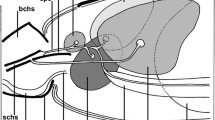Abstract
In normal fourth larval instar Chironomus larvae, the secretory protein component I (or 1, according to Grossbach, 1969) consists of two subfractions, Ia and Ib, with an average molecular weight of 850.000 D (Rydlander and Edström, 1980). Data in the preceding paper suggest that component I is coded for by 75S RNA derived from the two large Balbiani rings, BR1 and BR2 (Rydlander et al., 1980). If Chironomus pallidivittatus larvae are exposed to galactose, the size relations between BR1 and BR2, which are usually in favour of BR2, are inverted and upon prolonged exposure a new BR, BR6, appears (Beermann, 1973). Here we describe how one or two new subfractions within component I, Ic1 and Ic2, appear during treatment with galactose, in parallel with the development of BR6. During the treatment there is also a change in the ratio between Ia and Ib proteins so that Ia becomes dominant, whereas in controls Ib is more pronounced. Fractions Ia, Ib and Ic are at least partially immunologically different but Ic1 and Ic2 cannot be distinguished from each other. Since the relative amounts of Ic1 and Ic2 do not vary in extracts from single animals, we have assumed that they represent alle lic products. —Fraction Ic can become the dominating protein within component I during galactose treatment. Since component I accounts for about 50% of the total protein synthesis, the sugar treatment is accompanied by major quantitative changes in genetic expression. —The correlation between the occurrence of particular Balbiani rings and protein fractions, evident from measurements of either protein mass or amino acid incorporation remains in agreement with the general relation earlier shown to exist between the large Balbiani rings and the total component I. Our data support the hypothesis that BR1 codes for fraction Ia, BR2 for Ib and BR6 for Ic. Conclusive evidence will, however, have to be provided by molecular techniques.
Similar content being viewed by others
References
Beermann, W.: Riesenchromosomen. Protoplasmologia VI C. Wien: Springer 1962
Beermann, W.: Directed changes in the pattern of Balbiani ring puffing in Chironomus: Effects of sugar treatment. Chromosoma (Berl.) 41, 297–326 (1973)
Daneholt, B., Andersson, K., Fagerlind, M.: Large-sized polysomes in Chironomus tentans salivary glands and their relation to Balbiani ring 75S RNA. J. Cell Biol 73, 149–160 (1977)
Derksen, J.: Cytological analysis of Drosophila polytene chromosomes. In: Methods in cell biology (G. Stein, J. Stein and L.J. Kleinsmith, eds.), vol. 17, pp. 133–140. New York: Academic Press, 1978
Egyhazi, E.: Inhibition of Balbiani ring RNA synthesis at the initiation level. Proc. nat. Acad. Sci. (Wash.) 72, 947–950 (1975)
Grossbach, U.: Chromosomen-Aktivität und biochemische Zelldifferenzierung in den Speicheldrüsen von Camptochironomus. Chromosoma (Berl.) 28, 136–187 (1969)
Grossbach, U.: Chromosome puffs and gene expression in polytene cells. Cold Spr. Harb. Symp. quant. Biol. 38, 619–627 (1973)
Grossbach, U.: The salivary gland of Chironomus (Diptera). A model system for the study of cell differentiation. In: Biochemical differentiation in insect glands (W. Beermann, ed.), pp. 147–196, Berlin, Heidelberg, New York: Springer 1977
Hollenberg, C.P.: Proportionate representation of rDNA and Balbiani ring DNA in polytene chromosomes of Chironomus tentans. Chromosoma (Berl.) 57, 185–197 (1976)
Lamb, M.M., Daneholt, B.: Characterization of active transcription units in Balbiani rings of Chironomus tentans. Cell 17, 835–848 (1979)
Lambert, B., Beermann, W.: Homology of Balbiani ring DNA in two closely related Chironomus species. Chromosoma (Berl.) 51, 41–47 (1975)
Pankow, W., Lezzi, M., Holderegger-Mähling, I.: Correlated changes of Balbiani ring expansion and secretory protein synthesis in larval salivary glands of Chironomus tentans. Chromosoma (Berl.) 58, 137–153 (1976)
Rydlander, L., Edström, J.-E.: Large-sized nascent protein as dominating component during protein synthesis in Chironomus salivary glands. Chromosoma (Berl.) 81, 85–99 (1980)
Rydlander, L., Pigon, A., Edström, J.E.: Sequences translated by Balbiani ring 75S RNA in vitro are present in giant secretory protein from Chironomus tentans. Chromosoma (Berl.) 81, 101–113 (1980)
Wieslander, L., Daneholt, B.: Demonstration of Balbiani ring RNA sequences in polysomes. J. Cell Biol. 73, 260–264 (1977)
Author information
Authors and Affiliations
Rights and permissions
About this article
Cite this article
Edström, J.E., Rydlander, L. & Francke, C. Concomitant induction of a Balbiani ring and a giant secretory protein in Chironomus salivary glands. Chromosoma 81, 115–124 (1980). https://doi.org/10.1007/BF00292426
Received:
Accepted:
Issue Date:
DOI: https://doi.org/10.1007/BF00292426




